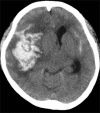Ruptured Mycotic Cerebral Aneurysm Secondary to Disseminated Nocardiosis
- PMID: 33708692
- PMCID: PMC7869307
- DOI: 10.4103/ajns.AJNS_283_20
Ruptured Mycotic Cerebral Aneurysm Secondary to Disseminated Nocardiosis
Abstract
We report a case of a ruptured mycotic cerebral aneurysm caused by Nocardia infection. A 22-year-old immunocompromised woman with adult-onset Still's disease developed a subarachnoid hemorrhage (SAH). Digital subtraction angiography revealed a small aneurysm at the M2-3 bifurcation of the right middle cerebral artery. Cardiac ultrasonography showed vegetation at the posterior cardiac wall, suspecting infective endocarditis (IE). Gram-positive filamentous bacteria were observed in the necrotic tissue surrounding the aneurysm obtained during trapping surgery. Long-term blood culture showed that the cause of her cerebral mycotic aneurysm was nocardiosis. A mycotic ruptured cerebral aneurysm is an important cause of SAH in immunocompromised patients. Early diagnosis of IE, detection of gram-positive rods by Gram staining, and long-term culture to identify the bacteria is crucial in diagnosing nocardiosis.
Keywords: Immunosuppressed host; nocardiosis; ruptured mycotic cerebral aneurysm.
Copyright: © 2020 Asian Journal of Neurosurgery.
Conflict of interest statement
There are no conflicts of interest.
Figures



Similar articles
-
A rare case of ruptured anterior cerebral artery infected aneurysm with angioinvasion secondary to disseminated Nocardia otitidiscaviarum: A case report and literature review.Surg Neurol Int. 2022 Sep 16;13:417. doi: 10.25259/SNI_734_2022. eCollection 2022. Surg Neurol Int. 2022. PMID: 36324939 Free PMC article.
-
Infective endocarditis caused by Nocardia nova: A case report and literature review of nocardial endocarditis.J Infect Chemother. 2021 Aug;27(8):1238-1243. doi: 10.1016/j.jiac.2021.02.023. Epub 2021 Mar 13. J Infect Chemother. 2021. PMID: 33722464 Review.
-
[Valve replacement in a patient with infective endocarditis and ruptured mycotic cerebral aneurysm].Nihon Kyobu Geka Gakkai Zasshi. 1992 Jan;40(1):118-23. Nihon Kyobu Geka Gakkai Zasshi. 1992. PMID: 1564343 Review. Japanese.
-
Ruptured Mycotic Aneurysm and Cerebral Vasospasm in the Setting of Endocarditis and Heart Failure Requiring Cardiothoracic Surgery: Case Report and Literature Review.World Neurosurg. 2017 Apr;100:711.e13-711.e18. doi: 10.1016/j.wneu.2017.01.076. Epub 2017 Jan 31. World Neurosurg. 2017. PMID: 28153625 Review.
-
Differentiating between Mycotic and Dissecting Aneurysms in a Case of Ruptured Distal Superior Cerebral Artery Aneurysm.J Neuroendovasc Ther. 2020;14(7):268-272. doi: 10.5797/jnet.cr.2019-0120. Epub 2020 Apr 8. J Neuroendovasc Ther. 2020. PMID: 37502617 Free PMC article.
Cited by
-
A rare case of ruptured anterior cerebral artery infected aneurysm with angioinvasion secondary to disseminated Nocardia otitidiscaviarum: A case report and literature review.Surg Neurol Int. 2022 Sep 16;13:417. doi: 10.25259/SNI_734_2022. eCollection 2022. Surg Neurol Int. 2022. PMID: 36324939 Free PMC article.
References
-
- Long PF. A retrospective study of Nocardia infections associated with the acquired immune deficiency syndrome (AIDS) Infection. 1994;22:362–4. - PubMed
-
- Tremblay J, Thibert L, Alarie I, Valiquette L, Pépin J. Nocardiosis in Quebec, Canada, 1988-2008. Clin Microbiol Infect. 2011;17:690–6. - PubMed
-
- Farran Y, Antony S. Nocardia abscessus-related intracranial aneurysm of the internal carotid artery with associated brain abscess: A case report and review of the literature. J Infect Public Health. 2016;9:358–61. - PubMed

